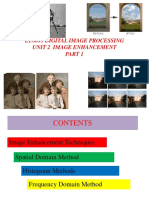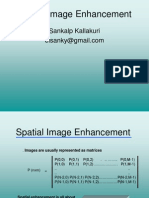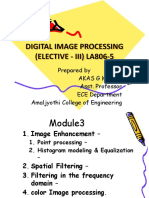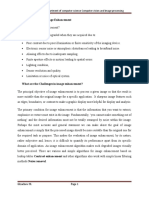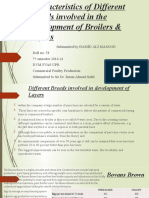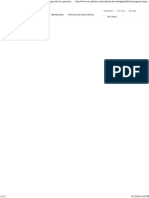Imagee
Uploaded by
Hitesh KumarImagee
Uploaded by
Hitesh KumarCYH/Imoge|nhoncemenf/p.
I
Image Enhancement
Introduction
Enhancement by point processing
Simple intensity transformation
Histogram processing
Spatial filtering
Smoothing filters
Sharpening filters
Enhancement in the frequency domain
Pseudo-color image processing
CYH/Imoge|nhoncemenf/p.Z
1. Introduction
The principal objective of image enhancement is to
process a given image so that the result is more
suitable than the original image for a specific
application.
It accentuates or sharpens image features such as
edges, boundaries, or contrast to make a graphic
display more helpful for display and analysis.
The enhancement doesn't increase the inherent
information content of the data, but it increases the
dynamic range of the chosen features so that they
can be detected easily.
I mage Enhancement
Point operation
Spatial operation Transform operation Pseudocoloring
O cont rast st ret chi ng
O Noi se cl i ppi ng
O Wi ndow sl i ci ng
O Hi st ogr am model i ng
O Noi se smoot hi ng
O Medi an f i l t eri ng
O LP, HP & BP f i l t eri ng
O Zoomi ng
O Li near f i l t eri ng
O Root f i l t eri ng
O Homomor phi c f i l t er i ng
O Fal se col ori ng
O Pseudocol or i ng
CYH/Imoge|nhoncemenf/p.3
The greatest difficulty in image enhancement is
quantifying the criterion for enhancement and,
therefore, a large number of image enhancement
techniques are empirical and require interactive
procedures to obtain satisfactory results.
Image enhancement methods can be based on either
spatial or frequency domain techniques.
Spatial domain enhancement methods:
Spatial domain techniques are performed to the
image plane itself and they are based on direct
manipulation of pixels in an image.
The operation can be formulated as g(x,y) =
T[f(x,y)], where g is the output, f is the input image
and T is an operation on f defined over some
neighborhood of (x,y).
According to the operations on the image pixels, it
can be further divided into 2 categories: Point
operations and spatial operations (including linear
and non-linear operations).
CYH/Imoge|nhoncemenf/p.4
Frequency domain enhancement methods:
These methods enhance an image f(x,y) by
convoluting the image with a linear, position
invariant operator.
The 2D convolution is performed in frequency
domain with DFT.
Spatial domain: g(x,y)=f(x,y)*h(x,y)
Frequency domain: G(w
1
,w
2
)=F(w
1
,w
2
)H(w
1
,w
2
)
CYH/Imoge|nhoncemenf/p.b
2. Enhancement by point processing
These processing methods are based only on the
intensity of single pixels.
2.1 Simple intensity transformation:
(a). Image negatives:
Negatives of digital images are useful in numerous
applications, such as displaying medical images and
photographing a screen with monochrome positive
film with the idea of using the resulting negatives as
normal slides.
Transform function T : g(x,y)=L-f(x,y), where L is
the max. intensity.
CYH/Imoge|nhoncemenf/p.o
Original
Negative
CYH/Imoge|nhoncemenf/p.7
(b). Contrast stretching
Low-contrast images can result from poor
illumination, lack of dynamic range in the image
sensor, or even wrong setting of a lens aperture
during image acquisition.
The idea behind contrast stretching is to increase the
dynamic range of the gray levels in the image being
processed.
CYH/Imoge|nhoncemenf/p.8
Original
Processed image
Special case: If r
1
=r
2
=0, s
1
=0 and s
2
=L-1, then it is
actually a thresholding that creates a binary images.
CYH/Imoge|nhoncemenf/p.9
(c). Compression of dynamic range
Sometimes the dynamic range of a processed image
far exceeds the capability of the display device, in
which case only the brightest parts of the images are
visible on the display screen.
An effective way to compress the dynamic range of
pixel values is to perform the following intensity
transformation function:
s = c log(1+|r|)
where c is a scaling constant, and the logarithm
function performs the desired compression.
Transform function
CYH/Imoge|nhoncemenf/p.I0
Original Processed output
(d) Gray-level slicing
Highlighting a specific range of gray levels in an
image often is desired. Applications include
enhancing features such as masses of water in
satellite imagery and enhancing flaws in x-ray
images.
CYH/Imoge|nhoncemenf/p.II
Example 1:
A transformation function that highlights a range
[A,B] of intensities while diminishing all others
to a constant.
(o)
(b) (c)
Fig I. (o) Tronsfer funcfion, (b) OriginoI imoge, (c)
Processing oufpuf.
CYH/Imoge|nhoncemenf/p.IZ
Example 2:
A transformation function that highlights a range
[A,B] of intensities but preserves all others.
CYH/Imoge|nhoncemenf/p.I3
2.2 Histogram processing:
The histogram of a digital image with gray levels in
the range [0,L-1] is a discrete function p(r
k
)=n
k
/n,
where r
k
is the kth gray level, n
k
is the number of
pixels in the image with that gray level, n is the total
number of pixels in the image, and k=0,1..L-1.
P(r
k
) gives an estimate of the probability of
occurrence of gray level r
k
.
The shape of the histogram of an image gives us
useful information about the possibility for contrast
enhancement.
A histogram of a narrow shape indicates little
dynamic range and thus corresponds to an image
having low contrast.
CYH/Imoge|nhoncemenf/p.I4
CYH/Imoge|nhoncemenf/p.Ib
(a) Histogram equalization
The objective is to map an input image to an output
image such that its histogram. is uniform after the
mapping.
Let r represent the gray levels in the image to be
enhanced and s is the enhanced output with a
transformation of the form s=T(r).
Assumption:
1. T(r) is single-valued and monotonically
increasing in the interval [0,1], which preserves
the order from black to white in the gray scale.
2. 1 ) ( 0 r T for 1 0 r , which guarantees the
mapping is consistent with the allowed range of
pixel values.
If P
r
(r) and T(r) are known and T
-1
(s) satisfies
condition (a), the pdf of the transformed gray levels
is
) (
1
) ( P ) ( P
s T r
r s
ds
dr
r s
If
r
r
dw w r T s
0
) ( P ) ( for 1 0 r , then we have
) ( P r
dr
ds
r
and hence 1 ) ( P s
s
for 1 0 s .
CYH/Imoge|nhoncemenf/p.Io
Using a transformation function equal to the
cumulative distribution of r produces an image
whose gray levels have a uniform density, which
implies an increase in the dynamic range of the
pixels.
In order to be useful for digital image processing,
eqns. should be formulated in discrete form:
n
n
r
k
k r
) ( P and
k
j
j
k k
n
n
r T s
0
) ( , where k=0,1...L-1
A plot of ) ( P
k r
r versus r
k
is actually a histogram,
and the technique used for obtaining a uniform
histogram is known as histogram equalization or
histogram linearization.
CYH/Imoge|nhoncemenf/p.I7
Example: Equalizing an image of 6 gray levels.
Index k 0 1 2 3 4 5
Normalized Input
level, r
k
/5
0.0 0.2 0.4 0.6 0.8 1.0
Freq. Count of r
k
, n
k
4 7 2 1 0 1
Probability P(r
k
) =
n
k
/n
4/15 7/15 2/15 1/15 0/15 1/15
k
j
j
k k
n
n
r T s
0
) (
4/15
= 0.27
11/15
= 0.73
13/15
= 0.87
14/15
= 0.93
14/15
= 0.93
15/15
= 1.00
Quantized s
k
0.2 0.8 0.8 1.0 1.0 1.0
0. 0
0. 2
0. 4
0. 6
0. 8
1. 0
0. 2
0. 8
0. 8
1. 0
1. 0
1. 0
T
r
k
s
k
4
7
2
1
0
1
4
7
2
1
0
1
freq
0. 0:
0. 2:
0. 4:
0. 6:
0. 8:
1. 0:
0
4
0
0
9
2
freq
0. 0:
0. 2:
0. 4:
0. 6:
0. 8:
1. 0:
Fig Z. |xompIe of hisfogrom equoIi;ofion
CYH/Imoge|nhoncemenf/p.I8
Original image
Histogram
CYH/Imoge|nhoncemenf/p.I9
Equalized image
Histogram
CYH/Imoge|nhoncemenf/p.Z0
(b) Histogram specification
Histogram equalization only generates an
approximation to a uniform histogram.
Sometimes the ability to specify particular
histogram shapes capable of highlighting certain
gray-level ranges in an image is desirable.
Procedures:
1. Determine the transformation ) (
k k
r T s that can
equalize the original image's histogram p
r
(r).
2. Determine the transformation ) (
k k
b G s that can
equalize the desired image's histogram p
b
(b).
3. Perform transformation )) ( (
1
k
r T G
.
The principal difficulty in applying the histogram
specification method to image enhancement lies in
being able to construct a meaningful histogram.
CYH/Imoge|nhoncemenf/p.ZI
(c) Local enhancement
It is often necessary to enhance details over small
areas.
The number of pixels in these areas may have
negligible influence on the computation of a global
transformation, so the use of global histogram
specification does not necessarily guarantee the
desired local enhancement.
Procedures:
1. Define a square or rectangular neighborhood
and move the center of this window from pixel
to pixel.
2. Determine the histogram equalization or
histogram specification transformation function
with the histogram of the windowed image at
each location.
3. Map the gray level centers in the window with
the transformation function.
4. Move to an adjacent pixel location and the
procedure is repeated.
CYH/Imoge|nhoncemenf/p.ZZ
(o) (b)
Fig 3. Imoge before ond offer IocoI enhoncemenf.
CYH/Imoge|nhoncemenf/p.Z3
3. Spatial Filtering:
The use of spatial masks for image processing is
called spatial filtering.
The masks used are called spatial filters.
Fig 4. Top cross secfions of bosic shopes for circuIorIy
symmefric frequency domoin fiIfer. 8offom cross
secfions of corresponding spofioI domoin fiIfers. (o)
Iowposs, (b) bondposs ond (c) highposs fiIfers.
CYH/Imoge|nhoncemenf/p.Z4
The basic approach is to sum products between the
mask coefficients and the intensities of the pixels
under the mask at a specific location in the image.
(2D convolution)
d
d i
d
d
j y i x f j i w y x R ) , ( ) , ( ) , (
where (2d+1)X(2d+1) is the mask size, w(i,j)'s are
weights of the mask, f(x,y) is input pixel at
coordinates (x,y), R(x,y) is the output value at (x,y).
*
If the center of the mask is at location (x,y) in the
image, the gray level of the pixel located at (x,y) is
replaced by R, the mask is then moved to the next
location in the image and the process is repeated.
This continues until all pixel locations have been
covered.
CYH/Imoge|nhoncemenf/p.Zb
3.1. Smoothing filter:
Smoothing filters are used for blurring and for noise
reduction.
Blurring is used in preprocessing steps, such as
removal of small details from an image prior to
object extraction, and bridging of small gaps in lines
or curves.
Noise reduction can be accomplishing by blurring
with a linear filter and also by nonlinear filtering.
(a). Low pass filtering
The key requirement is that all coefficients are
positive.
Neighborhood averaging is a special case of LPF
where all coefficients are equal.
It blurs edges and other sharp details in the image.
Example:
1
1
1
]
1
1 1 1
1 1 1
1 1 1
9
1
CYH/Imoge|nhoncemenf/p.Zo
(b). Median filtering
If the objective is to achieve noise reduction instead
of blurring, this method should be used.
This method is particularly effective when the noise
pattern consists of strong, spike-like components
and the characteristic to be preserved is edge
sharpness.
It is a nonlinear operation.
For each input pixel f(x,y), we sort the values of the
pixel and its neighbors to determine their median
and assign its value to output pixel g(x,y).
CYH/Imoge|nhoncemenf/p.Z7
OriginoI wifh (o) spike noise (b) whife noise
Medion fiIfering oufpuf
Low-poss fiIfering oufpuf
CYH/Imoge|nhoncemenf/p.Z8
3.2. Sharpening Filters
To highlight fine detail in an image or to enhance
detail that has been blurred, either in error or as a
natural effect of a particular method of image
acquisition.
Uses of image sharpening vary and include
applications ranging from electronic printing and
medical imaging to industrial inspection and
autonomous target detection in smart weapons.
(a). Basic highpass spatial filter
The shape of the impulse response needed to
implement a highpass spatial filter indicates that the
filter should have positive coefficients near its
center, and negative coefficients in the outer
periphery.
Example : filter mask of a 3x3 sharpening filter
1
1
1
]
1
1 1 1
1 8 1
1 1 1
9
1
The filtering output pixels might be of a gray level
exceeding [0,L-1].
CYH/Imoge|nhoncemenf/p.Z9
The results of highpass filtering involve some form
of scaling and/or clipping to make sure that the gray
levels of the final results are within [0,L-1].
(b). Derivative filters.
Differentiation can be expected to have the opposite
effect of averaging, which tends to blur detail in an
image, and thus sharpen an image and be able to
detect edges.
The most common method of differentiation in
image processing applications is the gradient.
For a function f(x,y), the gradient of f at coordinates
(x',y') is defined as the vector
) ' , ' (
) ' , ' (
y x
y
f
x
f
y x f
1
1
1
1
]
1
Its magnitude can be approximated in a number of
ways, which result in a number of operators such as
Roberts, Prewitt and Sobel operators for computing
its value.
CYH/Imoge|nhoncemenf/p.30
Example: masks of various operators
0
0
0
0
0 0 0
0
0
0
0 0 0
0
0
0
1
1
1 1 1 1
1 1
1
1
2
2
-1
-2
-1
-1
-1
-1
-1 -1 -1
-1 -2 -1
Prewitt
Roberts
Sobel
1 1
-1 -1
CYH/Imoge|nhoncemenf/p.3I
SobeI (V) SobeI (H)
SobeI
Fig b. |dge defecfion wifh vorious operofors (Oufpufs ore
normoIi;ed.)
CYH/Imoge|nhoncemenf/p.3Z
Prewiff
Poberf
Fig b (Conf.). |dge defecfion wifh vorious operofors (Oufpufs
ore normoIi;ed.)
CYH/Imoge|nhoncemenf/p.33
4. Enhancement in the frequency domain:
We simply compute the Fourier transform of the
image to be enhanced, multiply the result by a filter
transfer function, and take the inverse transform to
produce the enhanced image.
Spatial domain: g(x,y)=f(x,y)*h(x,y)
Frequency domain: G(w
1
,w
2
)=F(w
1
,w
2
)H(w
1
,w
2
)
Lowpass filtering
Edges and sharp transitions in the gray levels
contribute to the high frequency content of its
Fourier transform, so a lowpass filter smoothes an
image.
Formula of ideal LPF
else
D v u D if
v u H
o
'
) , (
0
1
) , (
(o) (b)
Fig o. (o) IdeoI LPF, (b) 8ufferworfh LPF.
CYH/Imoge|nhoncemenf/p.34
Highpass filtering
A highpass filter attenuates the low frequency
components without disturbing the high frequency
information in the Fourier transform domain can
sharpen edges.
Formula of ideal HPF function
else
D v u D if
v u H
o
'
) , (
1
0
) , (
(o) (b)
Fig 7. (o) IdeoI HPF, (b) 8ufferworfh HPF.
CYH/Imoge|nhoncemenf/p.3b
5. Pseudo color image processing
In automated image analysis, color is a powerful
descriptor that often simplifies object identification
and extraction from a scene.
Human eye performs much better in discerning
shades of color than gray scale.
A monochrome image can be enhanced by using
colors to represent different gray levels or
frequencies.
Gray level to color transformation
To perform 3 independent transformations on the
gray level of any input pixel. The three results are
then fed separately into the R, G, B guns of a color
monitor.
Red
t r ansf or mat i on
Gr een
t r ansf or mat i on
Bl ue
t r ansf or mat i on
i mage
f(x,y)
I
R
(x,y)
I
G
(x,y)
I
B
(x,y)
Fig 8. FuncfionoI bIock diogrom for pseudo-coIor
imoge processing.
CYH/Imoge|nhoncemenf/p.3o
This method produces a composite image whose
color content is modulated by the nature of the
transformation functions.
(o) (b)
Fig 9. Two exompIes of fronsformofion funcfions
These sinusoidal functions contain regions of
relatively constant value around the peaks as well as
regions that change rapidly near the valleys.
Changing the phase and frequency of each
sinusoidal can emphasize ranges in the gray scale.
A small change in the phase between the 3
transformations produces little change in pixels
whose gray levels correspond to peaks in the
sinusoidals (i.e. Case of ) , ( ) , ( ) , ( y x I y x I y x I
B G R
).
CYH/Imoge|nhoncemenf/p.37
Pixels with gray level values in the steep section of
the sinusoids are assigned a much stronger color
content as a result of significant differences between
the amplitudes of the 3 sinusoids caused by the
phase displacement between them.
(i.e. Case of ) , ( ) , ( ) , ( y x I y x I y x I
B G R
)
CYH/Imoge|nhoncemenf/p.38
(o)
(b) (c)
Fig I0. Pseudo-coIor enhoncemenf by using fhe groy-IeveI fo
coIor fronsformofions. (o) OriginoI imoge, (b) ond (c)
resuIfs obfoined wifh fronsformofion funcfions (o)
ond (b) respecfiveIy.
You might also like
- 13 Years Test Experience With Short Circuit Withstand Capability of Large Power TransformersNo ratings yet13 Years Test Experience With Short Circuit Withstand Capability of Large Power Transformers7 pages
- Coe4Tn3 Image Processing: Image Enhancement in The Spatial Image Enhancement in The Spatial DomainNo ratings yetCoe4Tn3 Image Processing: Image Enhancement in The Spatial Image Enhancement in The Spatial Domain12 pages
- Ch-3 Spatial and Frequency Domain Image ProcessingNo ratings yetCh-3 Spatial and Frequency Domain Image Processing52 pages
- 4 Lecture DIP Image Enhancement Spatial P1 DrTahirNawazNo ratings yet4 Lecture DIP Image Enhancement Spatial P1 DrTahirNawaz54 pages
- Image Transformation and Filtering: Priyanka PH.D Cse Uiet, PuNo ratings yetImage Transformation and Filtering: Priyanka PH.D Cse Uiet, Pu49 pages
- Ch2-Image Enhancement in Spacial DomainNo ratings yetCh2-Image Enhancement in Spacial Domain117 pages
- Image Enhancement: (C) 2002-2012 by Yu Hen HuNo ratings yetImage Enhancement: (C) 2002-2012 by Yu Hen Hu49 pages
- Module2 - Image Enhancement SD - PresentationNo ratings yetModule2 - Image Enhancement SD - Presentation38 pages
- Digital Image Processing (Chapter 3) PDFNo ratings yetDigital Image Processing (Chapter 3) PDF84 pages
- DIP Unit 2 (Enhancement, Binary, Colour)No ratings yetDIP Unit 2 (Enhancement, Binary, Colour)126 pages
- Comparative Study of Image Enhancement and Analysis of Thermal Images Using Image Processing and Wavelet TechniquesNo ratings yetComparative Study of Image Enhancement and Analysis of Thermal Images Using Image Processing and Wavelet Techniques7 pages
- Digital Image Processing 03 Image Enhancement in Spatial DomainNo ratings yetDigital Image Processing 03 Image Enhancement in Spatial Domain57 pages
- (IP'22) Lecture 3 - Enhancemet II - Spatial FilteringNo ratings yet(IP'22) Lecture 3 - Enhancemet II - Spatial Filtering127 pages
- Lecture - 11 - 16 ImageEnhancement - Till - March1 - 2023No ratings yetLecture - 11 - 16 ImageEnhancement - Till - March1 - 202376 pages
- Histogram Equalization: Enhancing Image Contrast for Enhanced Visual PerceptionFrom EverandHistogram Equalization: Enhancing Image Contrast for Enhanced Visual PerceptionNo ratings yet
- "HTML Project On Website For Uiit": Synopsis)No ratings yet"HTML Project On Website For Uiit": Synopsis)5 pages
- 2015 Flowserve Educational Services Course CatalogNo ratings yet2015 Flowserve Educational Services Course Catalog28 pages
- Lecture - 1 - Molecular Structure of Skeletal Muscle and Function of Nerve-Muscle JunctionNo ratings yetLecture - 1 - Molecular Structure of Skeletal Muscle and Function of Nerve-Muscle Junction16 pages
- Grade 8 Study List Term 3 Final Exam ZehranNo ratings yetGrade 8 Study List Term 3 Final Exam Zehran11 pages
- Characteristics of Different Breeds Involved in Development of Broilers & LayersNo ratings yetCharacteristics of Different Breeds Involved in Development of Broilers & Layers20 pages
- Vanna Venturi House: "Non Sequitur" and "Duality" in ArchitectureNo ratings yetVanna Venturi House: "Non Sequitur" and "Duality" in Architecture8 pages
- Comparison of The ASME, BS and CEN Fatigue Design Rules For Pressure Vessels (October 2003)No ratings yetComparison of The ASME, BS and CEN Fatigue Design Rules For Pressure Vessels (October 2003)2 pages
- Systemized Orthodontic Treatment Mechanics100% (1)Systemized Orthodontic Treatment Mechanics312 pages
- Commonlit They-Re-Made-Out-Of-Meat StudentNo ratings yetCommonlit They-Re-Made-Out-Of-Meat Student7 pages
- Computer Science Project On Java LanguageNo ratings yetComputer Science Project On Java Language163 pages
- The Book of Stolen Dreams Teaching Resources100% (1)The Book of Stolen Dreams Teaching Resources13 pages
- Wavelet Applications in Economics and Finance (PDFDrive)100% (1)Wavelet Applications in Economics and Finance (PDFDrive)271 pages
- 2010 Edward Cording - Assessment of Excavation Induced Building DamageNo ratings yet2010 Edward Cording - Assessment of Excavation Induced Building Damage20 pages
- Gadgets For Management of Stored Products InsectsNo ratings yetGadgets For Management of Stored Products Insects48 pages
- 13 Years Test Experience With Short Circuit Withstand Capability of Large Power Transformers13 Years Test Experience With Short Circuit Withstand Capability of Large Power Transformers
- Coe4Tn3 Image Processing: Image Enhancement in The Spatial Image Enhancement in The Spatial DomainCoe4Tn3 Image Processing: Image Enhancement in The Spatial Image Enhancement in The Spatial Domain
- Ch-3 Spatial and Frequency Domain Image ProcessingCh-3 Spatial and Frequency Domain Image Processing
- 4 Lecture DIP Image Enhancement Spatial P1 DrTahirNawaz4 Lecture DIP Image Enhancement Spatial P1 DrTahirNawaz
- Image Transformation and Filtering: Priyanka PH.D Cse Uiet, PuImage Transformation and Filtering: Priyanka PH.D Cse Uiet, Pu
- Comparative Study of Image Enhancement and Analysis of Thermal Images Using Image Processing and Wavelet TechniquesComparative Study of Image Enhancement and Analysis of Thermal Images Using Image Processing and Wavelet Techniques
- Digital Image Processing 03 Image Enhancement in Spatial DomainDigital Image Processing 03 Image Enhancement in Spatial Domain
- (IP'22) Lecture 3 - Enhancemet II - Spatial Filtering(IP'22) Lecture 3 - Enhancemet II - Spatial Filtering
- Lecture - 11 - 16 ImageEnhancement - Till - March1 - 2023Lecture - 11 - 16 ImageEnhancement - Till - March1 - 2023
- Histogram Equalization: Enhancing Image Contrast for Enhanced Visual PerceptionFrom EverandHistogram Equalization: Enhancing Image Contrast for Enhanced Visual Perception
- 2015 Flowserve Educational Services Course Catalog2015 Flowserve Educational Services Course Catalog
- Lecture - 1 - Molecular Structure of Skeletal Muscle and Function of Nerve-Muscle JunctionLecture - 1 - Molecular Structure of Skeletal Muscle and Function of Nerve-Muscle Junction
- Characteristics of Different Breeds Involved in Development of Broilers & LayersCharacteristics of Different Breeds Involved in Development of Broilers & Layers
- Vanna Venturi House: "Non Sequitur" and "Duality" in ArchitectureVanna Venturi House: "Non Sequitur" and "Duality" in Architecture
- Comparison of The ASME, BS and CEN Fatigue Design Rules For Pressure Vessels (October 2003)Comparison of The ASME, BS and CEN Fatigue Design Rules For Pressure Vessels (October 2003)
- Wavelet Applications in Economics and Finance (PDFDrive)Wavelet Applications in Economics and Finance (PDFDrive)
- 2010 Edward Cording - Assessment of Excavation Induced Building Damage2010 Edward Cording - Assessment of Excavation Induced Building Damage















